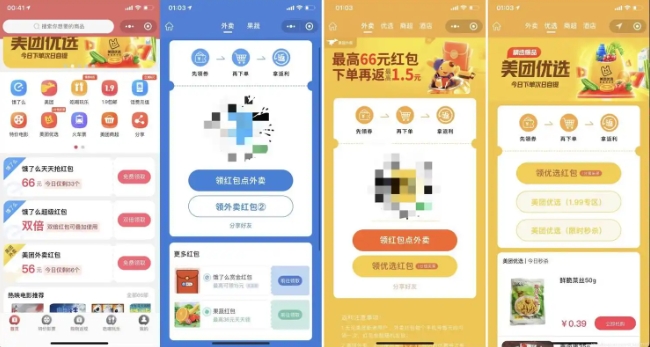Group Buying Takeout System: The Core Business Driver in the Digital Era
- latest articles
- 1.DApp Development & Customization: Merging Diverse Market Needs with User Experience 2.Analysis of the Core Technical System in DApp Project Development 3.How to achieve cross-chain interoperability in Web3 projects? 4.How does the tokenization of points reconstruct the e-commerce ecosystem? 5.How to Set and Track Data Metrics for a Points Mall? 6.What is DApp Development? Core Concepts and Technical Analysis 7.Inventory of commonly used Web3 development tools and usage tips 8.Development of a Distribution System Integrated with Social E-commerce 9.Six Key Steps for Businesses to Build a Points Mall System 10.What is DApp Development? A Comprehensive Guide from Concept to Implementation
- Popular Articles
- 1.Future Trends and Technology Predictions for APP Development in 2025 2.Analysis of the DeFi Ecosystem: How Developers Can Participate in Decentralized Finance Innovation 3.From Zero to One: How PI Mall Revolutionizes the Traditional E-commerce Model 4.DAPP Development | Best Practices for Professional Customization and Rapid Launch 5.Recommended by the Web3 developer community: the most noteworthy forums and resources 6.How to Develop a Successful Douyin Mini Program: Technical Architecture and Best Practices 7.From Cloud Computing to Computing Power Leasing: Building a Flexible and Scalable Computing Resource Platform 8.Shared Bike System APP: The Convenient Choice in the Era of Smart Travel 9.How to Create a Successful Dating App: From Needs Analysis to User Experience Design 10.From Design to Development: The Complete Process of Bringing an APP Idea to Life
With the rapid advancement of digital technology, business models are undergoing profound changes continuously. In this context, group-buying food delivery systems have emerged as a new business model, quickly rising to occupy a significant position in the market. Particularly in the catering industry, these systems not only effectively address users' purchasing needs but also enhance merchants' operational efficiency, becoming one of the core drivers of business in the digital era.
This article will delve into the definition, development history, operational models of group-buying food delivery systems, and how they have become a driving force in the digital age. Through an analysis of the current market environment, we can see how these systems effectively help businesses stand out in a highly competitive market.
I. Definition and Functions of Group-Buying Food Delivery Systems
1.1 Definition of Group-Buying Food Delivery Systems
A group-buying food delivery system is an online service platform that integrates various functions such as food delivery, group-buying discounts, and user reviews through an internet platform. Users can browse restaurants, select food items, and enjoy price discounts through group purchases. Merchants, in turn, use the platform to increase sales, attract more customers, and better manage orders and user needs.
1.2 Functions of Group-Buying Food Delivery Systems
Group-buying food delivery systems are not just simple platforms for processing food delivery orders; they are comprehensive business tools integrating multiple functions. Their core functions include:
Online Ordering and Payment: Users can view menus, select items, and make payments through the platform, supporting various payment methods such as Alipay and WeChat Pay.
Group-Buying Discounts: Users can enjoy group-buying discounts provided by the platform, such as discounts for reaching a certain amount or group orders, thereby increasing their willingness to purchase.
Delivery Management: The system intelligently schedules delivery times and assigns delivery personnel based on factors like the user's delivery address, the merchant's location, and order volume.
User Reviews and Recommendations: Users can rate the food and service, and others can use these reviews to choose suitable merchants.
Data Analysis and Decision Support: Merchants can analyze sales data, user preferences, and other information through the system to optimize products and services, thereby improving profitability.

II. Development History of Group-Buying Food Delivery Systems
2.1 Early Stage: The Rise of Food Delivery Services
The development of group-buying food delivery systems can be traced back to the late 20th and early 21st centuries when the internet was just becoming widespread, and the catering industry was gradually embracing digital transformation. The initial food delivery service models were relatively simple, with merchants typically taking orders over the phone and handling deliveries manually, which imposed certain limitations on both user experience and merchant management. However, with the rapid development of e-commerce, the proliferation of online payments, mobile internet, and smart devices, group-buying food delivery platforms began to emerge.
2.2 Middle Stage: The Integration of Group Buying and Food Delivery
Around 2010, the combination of group buying and food delivery services became a trend. Group-buying websites like Meituan and Lashou began expanding into the catering industry, attracting users to purchase food delivery through group-buying discounts. At this stage, group-buying food delivery systems not only provided delivery services but also integrated group-buying discounts for dining consumption. Merchants attracted more customers through discounts, while consumers enjoyed better value for money through group purchases.
As user demand for online food delivery services grew, platforms began introducing more intelligent systems, offering features such as order tracking, real-time payments, and personalized recommendations. During this phase, group-buying food delivery systems gradually became essential tools for business competition, especially in the catering industry, where merchants leveraged the technological advantages of platforms to increase their market share.
2.3 Current Stage: Comprehensive Digitalization and Intelligence
Entering the 2020s, group-buying food delivery systems have entered an era of comprehensive digitalization and intelligence. Today, these platforms are no longer just tools for providing group-buying discounts; they have evolved into business ecosystems powered by big data and artificial intelligence. By analyzing user behavior data, platforms can precisely recommend food items to users, optimize delivery routes, and achieve intelligent delivery. In some scenarios, merchants can even use robots or drones to complete deliveries.
Additionally, platforms have begun expanding into more vertical sectors, such as retail products and pharmaceuticals beyond the catering industry, driving the digital transformation of other sectors. Group-buying food delivery systems are no longer just sales tools for the catering industry but have become the core of business competition across various industries.
III. Business Value of Group-Buying Food Delivery Systems
3.1 Driving Force for Merchants
Group-buying food delivery systems provide numerous business values for merchants, with the most significant being the facilitation of precise marketing and efficient management. Through the data analysis provided by the system, merchants can understand consumer needs and purchasing habits, enabling them to develop more scientific marketing strategies.
Precise Market Positioning: Merchants can segment the market based on data such as users' purchase history and browsing habits to identify potential target customers.
Cost Control: Group-buying food delivery systems effectively help merchants reduce operational costs by automating management, optimizing delivery routes, and minimizing manual intervention, thereby improving delivery efficiency and saving costs.
Brand Building: Through user reviews and feedback, merchants can better understand consumer preferences, promptly improve products and services, and enhance their brand's market competitiveness.
3.2 Driving Force for Consumers
For consumers, the group-buying discounts and convenient shopping experience offered by group-buying food delivery systems are the most direct attractions. Through group buying, consumers can enjoy more favorable prices, while also making more informed purchasing decisions by comparing prices and reading user reviews on the platform.
Price Advantage: Group-buying food delivery platforms typically offer attractive discounts and special deals, encouraging users to make purchases.
Convenient Shopping Experience: Users can complete selection, payment, and ordering on their mobile phones, enjoying fast food delivery services that greatly enhance convenience.
Personalized Recommendations: Platforms intelligently recommend products that match users' needs based on their order history and preferences, improving the overall shopping experience.
3.3 Driving Force for the Industry
Group-buying food delivery systems not only impact the catering industry but also drive the digital transformation of the entire retail sector. With the support of intelligence, big data, and artificial intelligence, the digitalization process of traditional industries has accelerated. For example, the delivery systems and big data analytics of group-buying food delivery platforms can provide similar solutions for other industries, promoting transformation in retail, logistics, and more.

IV. Challenges and Future Development Trends of Group-Buying Food Delivery Systems
4.1 Continuous Optimization of User Experience
Although group-buying food delivery systems have achieved success in many aspects, they still face challenges such as delivery timeliness, food quality, and user privacy. In the future, platforms need to further optimize the user experience, improve delivery speed, ensure food safety, and place greater emphasis on user privacy protection.
4.2 Enhancing Technological Innovation Capabilities
As competition intensifies, group-buying food delivery platforms must continuously innovate technologically, leveraging cutting-edge technologies such as artificial intelligence, the Internet of Things, and big data to enhance service quality and operational efficiency. For example, through intelligent delivery systems and unmanned delivery technologies, platforms can reduce costs while improving user satisfaction.
4.3 Expanding into New Business Scenarios
In the future, group-buying food delivery systems will no longer be limited to the food delivery sector. Merchants can use the platform to expand into more business scenarios. For instance, these systems can integrate with supermarkets, e-commerce platforms, pharmaceutical delivery, and other industries to provide more comprehensive digital services.
V. Conclusion
As a core driver of business in the digital era, group-buying food delivery systems have profoundly transformed traditional business models and propelled the digital transformation of the catering industry and beyond. Through precise market positioning, intelligent management, and efficient services, these systems not only bring more profits to merchants but also provide consumers with more convenient and affordable shopping experiences. In the future, with continuous technological advancements and evolving market demands, group-buying food delivery systems will continue to lead business innovation and become a powerful tool for competition among more enterprises.
-

How to Use App Development to Boost Conversion Rates on E-commerce Platforms
With the widespread adoption of smartphones and the rapid development of mobile ···
-

How APP Development Facilitates Digital Transformation and Innovation
With the rapid advancement of information technology, digital transformation has···
-

App Store Optimization and SEO Strategies in App Development
In today's rapidly evolving mobile internet landscape, apps have become essentia···

 Blockchain
Blockchain










